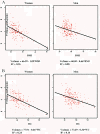Waist circumference vs body mass index in association with cardiorespiratory fitness in healthy men and women: a cross sectional analysis of 403 subjects
- PMID: 23317009
- PMCID: PMC3564926
- DOI: 10.1186/1475-2891-12-12
Waist circumference vs body mass index in association with cardiorespiratory fitness in healthy men and women: a cross sectional analysis of 403 subjects
Abstract
Objective: Body mass index (BMI) is more commonly used than waist circumference as a measure of adiposity in clinical and research settings. The purpose of this study was to compare the associations of BMI and waist circumference with cardiorespiratory fitness.
Methods: In a cross-sectional study of 403 healthy men and women aged 50 ± 8.8 years, BMI and waist circumference were measured. Cardiorespiratory fitness was assessed from estimated maximal O2 uptake (VO2max), as calculated from a maximal fitness test.
Results: Mean BMI (kg/m2) was 27.8 ± 3.7 and 25.5 ± 4.6; and mean waist circumference (cm) 94.1 ± 9.7 and 84.3 ± 10.4 for men and women, respectively. Both men and women reported an average of 2.5 hours of weekly sports related physical activity, and 18% were current smokers. Correlation coefficients between both BMI and waist circumference, and VO2max were statistically significant in men (r= -0.280 and r= -0.377, respectively, p>0.05 for both) and in women (r= -0.514 and r= -0.491, respectively, p>0.05 for both). In women, the contribution of BMI to the level of VO2max in a regression model was greater, while in men waist circumference contributed more to the final model. In these models, age, hours of training per week, and weekly caloric expenditure in sport activity, significantly associated with VO2max, while smoking did not.
Conclusion: The differences observed between the sexes in the associations of BMI and waist circumference with VO2max support the clinical use of both obesity measures for assessment of cardiorespiratory fitness.
Figures

Similar articles
-
The associations of cardiorespiratory fitness, adiposity and sports participation with arterial stiffness in youth with chronic diseases or physical disabilities.Eur J Prev Cardiol. 2017 Jul;24(10):1102-1111. doi: 10.1177/2047487317702792. Epub 2017 Apr 4. Eur J Prev Cardiol. 2017. PMID: 28374647 Free PMC article.
-
Addition of Cardiorespiratory Fitness Within an Obesity Risk Classification Model Identifies Men at Increased Risk of All-Cause Mortality.Am J Med. 2016 May;129(5):536.e13-20. doi: 10.1016/j.amjmed.2015.11.015. Epub 2015 Nov 28. Am J Med. 2016. PMID: 26642906
-
[Anthropometry and cardiorespiratory fitness of military men in active duty, Brazil].Rev Saude Publica. 2008 Apr;42(2):217-23. doi: 10.1590/s0034-89102008000200005. Rev Saude Publica. 2008. PMID: 18372973 Portuguese.
-
The relationship between body mass index and waist circumference: implications for estimates of the population prevalence of overweight.Int J Obes Relat Metab Disord. 2000 Aug;24(8):1058-61. doi: 10.1038/sj.ijo.0801359. Int J Obes Relat Metab Disord. 2000. PMID: 10951546
-
Interindividual Differences in Trainability and Moderators of Cardiorespiratory Fitness, Waist Circumference, and Body Mass Responses: A Large-Scale Individual Participant Data Meta-analysis.Sports Med. 2022 Dec;52(12):2837-2851. doi: 10.1007/s40279-022-01725-9. Epub 2022 Jul 4. Sports Med. 2022. PMID: 35781787 Review.
Cited by
-
Association of nonalcoholic fatty liver disease with incident dementia later in life among elderly adults.Clin Mol Hepatol. 2022 Jul;28(3):481-482. doi: 10.3350/cmh.2022.0097. Epub 2022 May 16. Clin Mol Hepatol. 2022. PMID: 35570004 Free PMC article. No abstract available.
-
Short Telomere Length is Associated with Aging, Central Obesity, Poor Sleep and Hypertension in Lebanese Individuals.Aging Dis. 2018 Feb 1;9(1):77-89. doi: 10.14336/AD.2017.0310. eCollection 2018 Feb. Aging Dis. 2018. PMID: 29392083 Free PMC article.
-
Risk Factors and Disability Associated with Low Back Pain in Older Adults in Low- and Middle-Income Countries. Results from the WHO Study on Global AGEing and Adult Health (SAGE).PLoS One. 2015 Jun 4;10(6):e0127880. doi: 10.1371/journal.pone.0127880. eCollection 2015. PLoS One. 2015. PMID: 26042785 Free PMC article.
-
Relationship between anthropometric characteristics and aerobic fitness among Malaysian men and women.J Exerc Rehabil. 2021 Feb 23;17(1):52-58. doi: 10.12965/jer.2142026.013. eCollection 2021 Feb. J Exerc Rehabil. 2021. PMID: 33728289 Free PMC article.
-
Multicollinearity in Regression Analyses Conducted in Epidemiologic Studies.Epidemiology (Sunnyvale). 2016 Apr;6(2):227. doi: 10.4172/2161-1165.1000227. Epub 2016 Mar 7. Epidemiology (Sunnyvale). 2016. PMID: 27274911 Free PMC article.
References
-
- Klein S, Allison DB, Heymsfield SB. Association for Weight Management and Obesity Prevention; NAASO; Obesity Society; American Society for Nutrition; American Diabetes Association; Association for Weight Management and Obesity Prevention; NAASO, the Obesity Society; the American Society for Nutrition; and the American Diabetes Association et al.Waist circumference and cardiometabolic risk: a consensus statement from shaping America’s health. Diabetes Care. 2007;30:1647–1652. doi: 10.2337/dc07-9921. - DOI - PubMed
MeSH terms
LinkOut - more resources
Full Text Sources
Other Literature Sources
Medical

